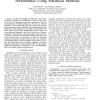Free Online Productivity Tools
i2Speak
i2Symbol
i2OCR
iTex2Img
iWeb2Print
iWeb2Shot
i2Type
iPdf2Split
iPdf2Merge
i2Bopomofo
i2Arabic
i2Style
i2Image
i2PDF
iLatex2Rtf
Sci2ools
ASPDAC
2006
ACM
2006
ACM
Analysis of scratch-pad and data-cache performance using statistical methods
— An effectively designed and efficiently used memory hierarchy, composed of scratch-pads or cache, is seen today as the key to obtaining energy and performance gains in data-dominated embedded applications. However, an unsolved problem is – how to make the right choice between the scratchpad and the data-cache for different class of applications? Recent studies show that applications with regular and manifest data access patterns (e.g. matrix multiplication) perform better on the scratch-pad compared to the cache. In the case of dynamic applications with irregular and non-manifest access patterns, it is however commonly and intuitively believed that the cache would perform better. In this paper, we show by theoretical analysis and empirical results that this intuition can sometimes be misleading. When access-probabilities remain fixed, we prove that the scratch-pad, with an optimal mapping, will always outperform the cache. We also demonstrate how to map dynamic applications ef�...
Related Content
| Added | 13 Jun 2010 |
| Updated | 13 Jun 2010 |
| Type | Conference |
| Year | 2006 |
| Where | ASPDAC |
| Authors | Javed Absar, Francky Catthoor |
Comments (0)

